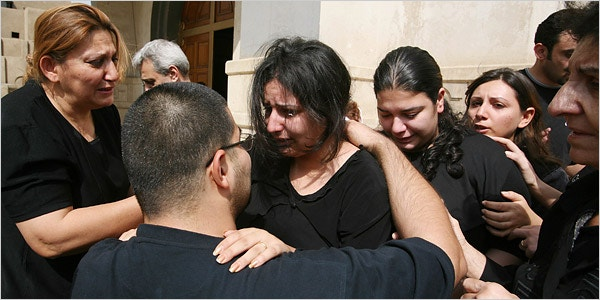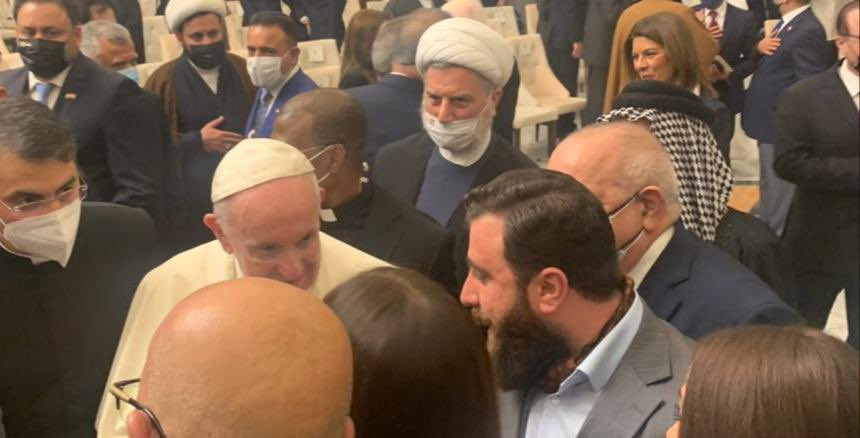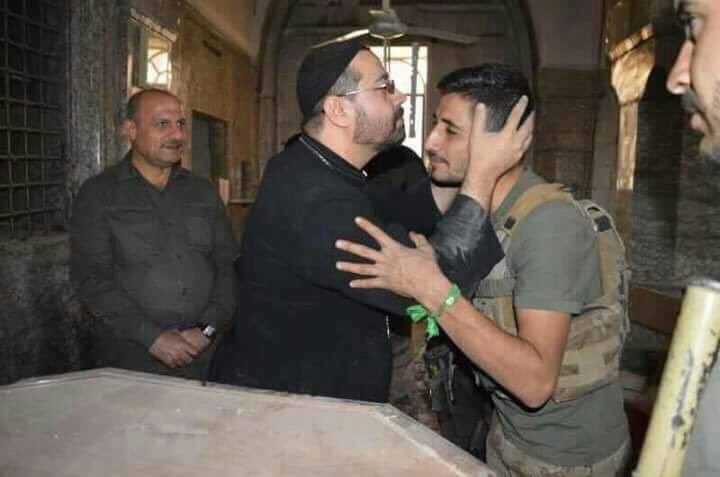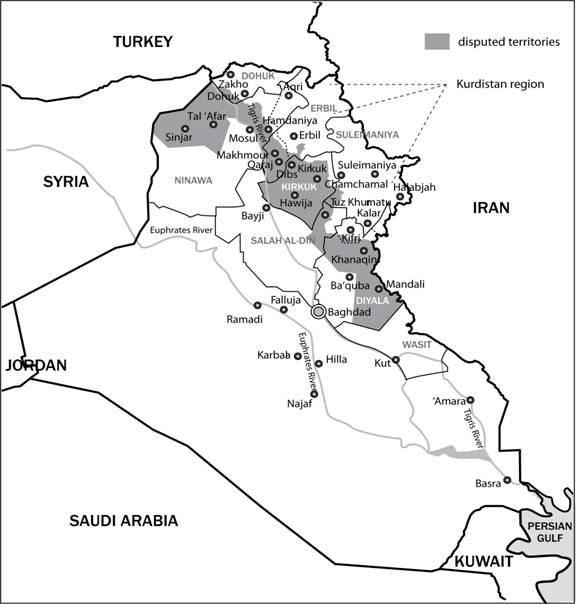The pope in Iraq and the medias’ historical revisionism
From March 5-8 Pope Francis visited Iraq for the first time. The discourse used by the worlds' media outlets on the visit was a clear reflection of their orientalist views and neo-colonial policies pursued in Iraq. In this article we will critically reflect on the media discourse surrounding the Pope’s visit to Najaf.
Disclaimer:
Many if not most of Iraq's Christians identify themselves as ethnically Assyrian. Others identify themselves by the church they belong to. The majority belong to the Catholic Chaldean church. That is why some prefer to be called either Chaldean or Chaldo-Assyrian while others identify themselves as Syriac Orthodox, Syriac Catholic or Armenian. All of these groups shared the same painful fate, that is why in this article we shall refer to all of the groups as Christians. This is in no way an attempt to deny the unique identity of the different groups.
The pope's visit to Grand Ayatollah Al Sistani
On Saturday March the 6th Pope Francis made a historic visit to Grand Ayatollah Sayid Ali Al Sistani. The grand Ayatollah is arguably one of the most important Muslim leaders in the world. The meeting took place in the holy city of Najaf in Sayid Sistani’s modest rental house where Sistani has lived for the past six decades. The unprecedented visit drew the attention of media outlets from around the world.

The first article we take a look at is Nu.nl’s “Pope and Shia Ayatollah have a historic meeting in Iraq" (own translation). With 7.220.000 visitors the last year, www.nu.nl comes in second as the most visited news website in the Netherlands.[1]
The first paragraph states:
The meeting between the head of the Roman Catholic Church and the supreme spiritual leader for millions of Shia Muslims was deeply symbolic. The two faiths have regularly conflicted violently for over a thousand years.
The Guardian wrote something similar stating:
Two of the most influential faith leaders in the world reached across a religious divide on Saturday to promote peace and unity in a historic meeting.
The article starts off with a reductive colonial narrative that claims that the two faiths have regularly conflicted with each other for over a thousand years. An all encompassing analysis of the local history is beyond the scope of this article. We will suffice with the following statement: the word conflict does not describe the nature of the relationship between the Christian and Islamic belief systems. A better point of reference regarding this part of history is the uncivilized hoards of “Christianized” Anglo-Saxon and Germanic peoples who went to West-Asia in 1095. These crusaders brutally slaughtered, robbed and raped on a mass scale both the “eastern” Christians and Muslims. These violent events interrupted a social reality of co-existence, interfaith exchange, trade, science and politics between Jews, Christians and Muslims in the region for centuries.
In more recent history the west ripped lands like Iraq apart to violently impose nation-states upon a diverse group of people. It appears that there is a pattern: whenever the west gets involved in the region, the delicate social fabric gets disturbed with cycles of violence that ripple for years to come.
Rewriting history
In the the second paragraph of the Nu.nl article it’s said that:
In addition, Iraq is home to a small Christian minority that has suffered attacks from Shia militias since the fall of Saddam Hussein in 2003. The Sunni Islamic State movement, which took over large parts of Iraq, also persecuted Christians. Less than 250,000 Christian Iraqis still live in Iraq, church leaders estimate.
In this paragraph the writer starts with a blatant lie by blaming Shia “militias” for the exodus of Christians since 2003. While it is true that the year of 2003 saw an exodus of Christians, all groups referred to as Shia “militias” but one, were formed some time after most of Iraq’s christians had already fled the country. It is important to note that the groups that are called “Shia militias” or the PMU’s (Popular Mobilization Units) are made up of all Iraqi sects and are officially part of the Iraqi security forces.
In the same paragraph the writer then proceeds to mention the “Islamic” state and writes that they “also” persecuted Christians. The article reduces the horrors inflicted on all Iraqis by the “Islamic” state to a side fact to the alleged attacks by “Shia Militias''. Note how media pundits are willing to downplay even the horrors of the so-called “Islamic” state to further their agenda.
Christian refugees were part of a larger flight of Iraqis fleeing the violence of the war and the occupation. According to a report that quotes UN sources most Christians had fled Iraq by 2006:
Christians formed the largest groups of new refugees arriving in Jordan’s capital Amman in the first quarter of 2006. In Syria, 44 per cent of Iraqi asylum-seekers were recorded as Christian since UNHCR began registrations in December 2003, with new registrations hitting a high in early 2006. The Sunni Islamic State movement, which took over large parts of Iraq, also persecuted Christians. Less than 250,000 Christian Iraqis still live in Iraq, church leaders estimate. [2]
While reading these statistics, one should keep in mind that both Jordan and Syria had up to a million Iraqi refugees in their countries.
In the western media it is left unmentioned that Iraqi Christians left the country because the US-led occupation killed more than a million civilians, destroyed the state apparatus and institutionalized sectarianism by enforcing a quota-system.
The occupation forces were also directly involved in killing Christians. In 2007 Jeniva Jalal, and Marany Awanees were killed when a private security company shot at their car. They both belonged to the Christian Armenian community.[3]

The 2009 Human Rights Watch report titled: “Vulnerable Ground: violence against minority communities Nineveh provinces disputed” documented attacks on minorities extensively. Not a single attack was attributed to "Shia militias". While most of the attacks were either claimed by or attributed to Wahhabi extremists, interviewees cited in this report also blame power hungry Kurdish politicians of attacking Christian minorities. [4]
While the displacement of Christians by ISIS has been documented extensively, the writer chooses to picture “Shia militias” as the problem however reverend Bashar Warda states the following:
Christianity in Iraq," he said, "one of the oldest Churches, if not the oldest Church in the world, is perilously close to extinction. Those of us who remain must be ready to face martyrdom.
He referred to the current, pressing threat from Islamic State (IS) jihadists as a "final, existential struggle", following the group's initial assault in 2014 that displaced more than 125,000 Christians. from their historic homelands.[5]
The so-called Shia militias were in fact the force that battled the “Islamic State” and liberated the land. The role the US and their allies played in sowing sectarianism and facilitating terror groups was explained in one of our previous articles.[6]
A masterclass in Orwellian doublethink
The writer of the nu.nl article explains the influence of Al Sistani in Iraq the following way:
Al Sistani has a lot of influence in Iraq and the rest of the Middle East. He was instrumental in shaping democratic elections in his country in 2005, mobilizing thousands of Iraqis to fight Islamic State a decade later and toppled a government after mass protests in 2019.
In this paragraph those very same “Shia militias” who were falsely blamed for the Christian exodus are mentioned again but this time they are remembered as the thousands that were mobilized by Sayed Al Sistani to liberate the lands from the “Islamic” state.
Al-Jazeera writes as well:
For Iraq’s dwindling Christian minority, a show of solidarity from Al-Sistani could help secure their place in Iraq after years of displacement – and, they hope, ease intimidation from Shia armed groups against their community.[7]
And this is what AP news said:
Iraq’s Christians, battered by violence and discrimination, hope a show of solidarity from al-Sistani will help secure their place in Iraq and ease intimidation from Shiite militiamen against their community.[8]
Both Al-Jazeera and AP also criminalize the force that liberated the lands from the threat of the “Islamic State”.
What happened during the visit

In contradiction to what the media portrayed, the pope thanked Al -Sistani and the Shia community for taking a stance against terror. Moreover, during his trip, the pope even gifted his rosary to Rayan Al Kaldani, a Christian commander of one of the brigades of the “Shia militias”. The trip of the Pope was so meticulously planned to the detail, that this cannot be dismissed as a mere coincidence. The pope and the Vatican delegation knew perfectly well who Al Kaldani was. Him meeting Al Kaldani and gifting him his rosary proves that he considers the PMU protectors of the Christians.

The very same people that sacrificed their lives and defeated the terror that grew out of the chaos of the US-led Invasion are being demonized to rewrite history that fits Neo Colonial policies and orientalist perspectives.
References
1:

4:

5: https://www.bbc.com/news/world-middle-east-48333923
6: https://irqnow.com/placing-the-2006-al-askari-shrine-bombing-in-context/
7: https://www.aljazeera.com/news/2021/3/6/pope-francis-meets-iraqs-shia-leader-al-sistani

